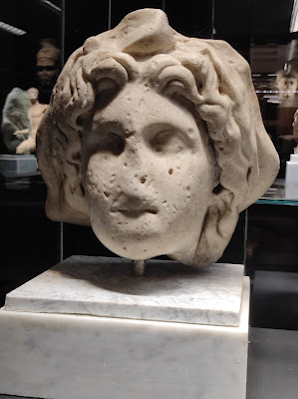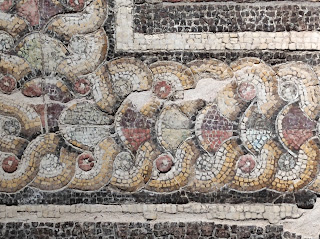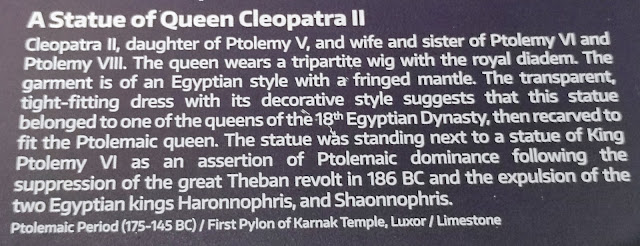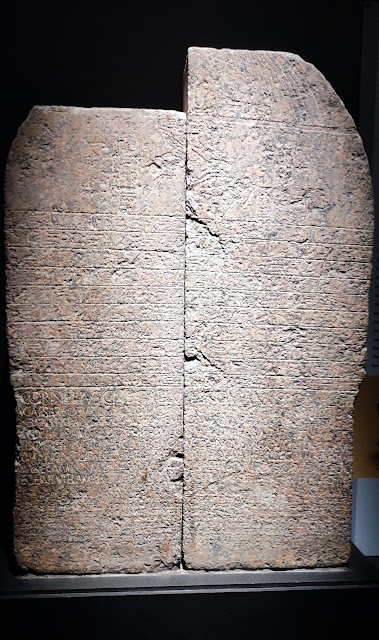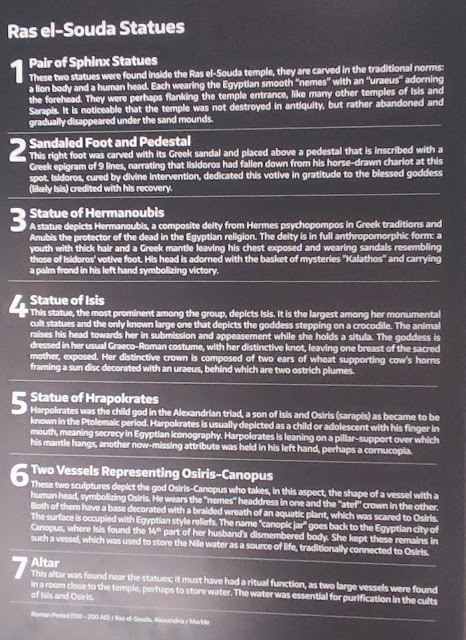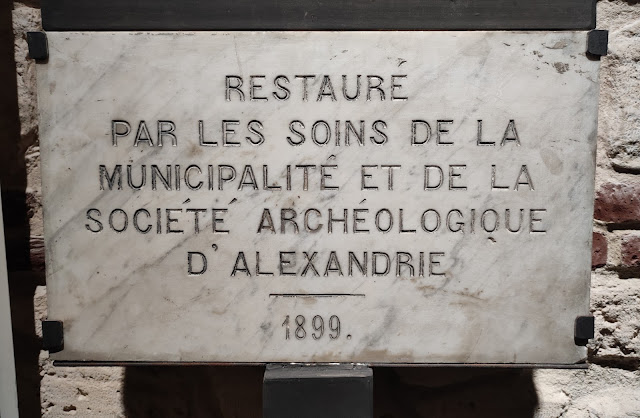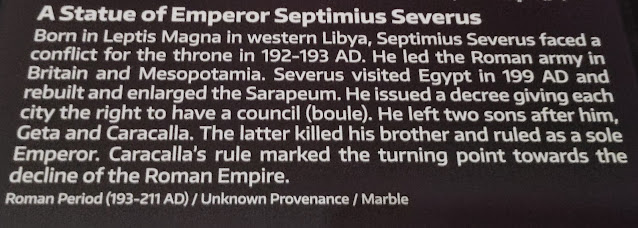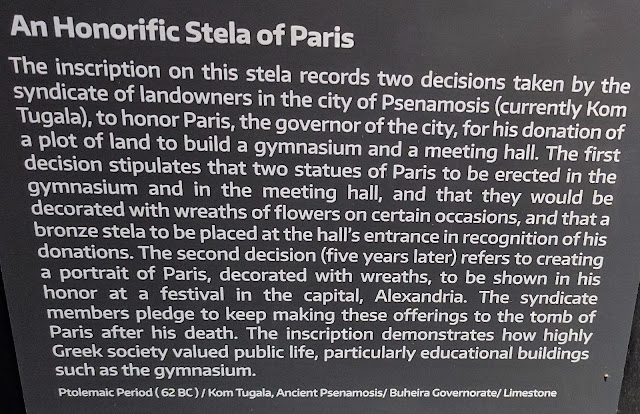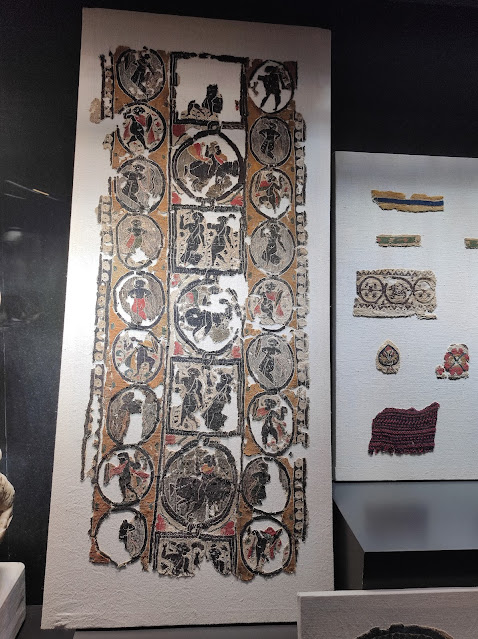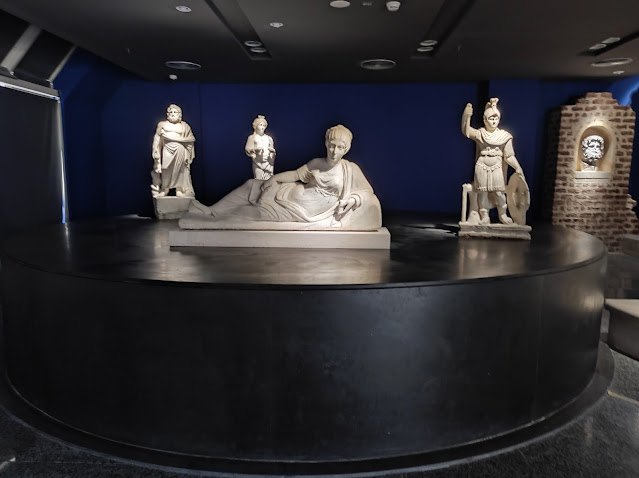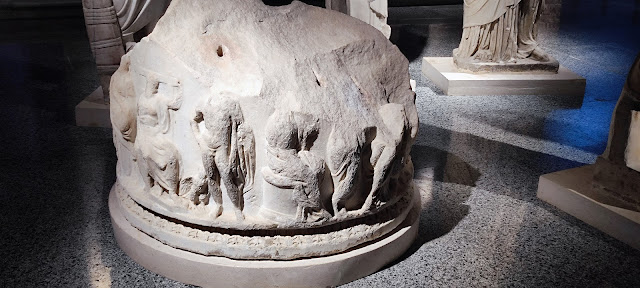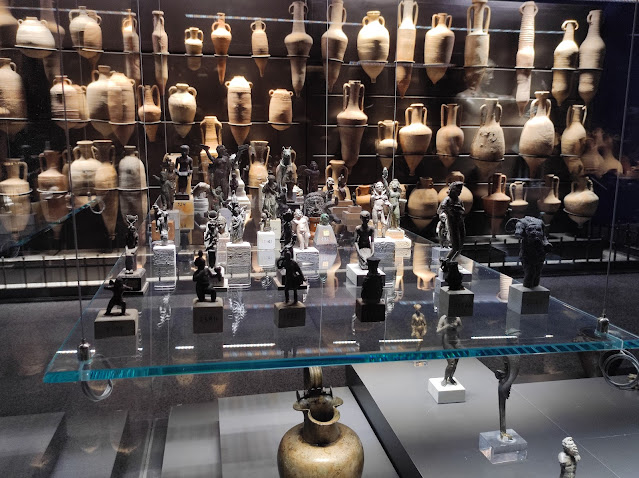Destination
The Graeco-Roman Museum of Alexandria
Text and photos © Iannis Kallianiotis
October 2023. A narration by an Alexandrian of his first visit of the newly opened Graeco-Roman Museum in Alexandria, Egypt. Updated on October 2024.
One of the "sleeping beauties" of the 1960's and 70's. We were still children and passing by, we marveled upon reading " ΜΟΥΣΕΙΟΝ "... Look ! ... its written in Greek!
By that time the city's Greek community was fading away, recent archeological excavations were scarce in the city. Tzallas' and Empereur's underwater explorations were to come and reveal brilliant granitic Ptolemaic statues, mosaics and rich remains.
Only the lonely voice of the city's Poet, insisted from the deserted (since 1933) rooms of Rue Lepsius, narrating the city's Hellenistic years, those of Syria, Pentapolis, Libya, partly pagan and partly Christianising.
Nevertheless, myths and their echo persisted... Passing by Nabi Daniel Mosque, in our father's car, heading towards the nearby Greek Cathedral, he would slip a word about Komoutsos, garçon de café, who reinvented himself into archeological sleuth, and aspired in discovering the "Soma" of Alexander the Great. Father's narrative was playful, yet unable to deter a certain degree of admiration and awe...
Anyway, myths do not need much to survive. You're surrounded by an architectural "soma" built after the English bombardment of the city in 1882, in a style predominantly neo-classic, mainly by Italian architects, such a match to the teaching of our professors in Averoff High School, and the light breeze coming from the sea, the sea, that is always close to you in Alexandria... where some lightness and beauty was never a sin...
Memories of my last visit of the Museum, many years ago, still a child, left a hazy impression of dusty displays and rather indifferent exhibits.
The renovation lasted for long years, almost 18, and expectations were not really that high...
Still, any prejudice was brilliantly taken to pieces, by hard working archeologists, museologists, architects, builders and administration. The result, measures up to the city's history, to the city's glory!
At the approach of the Museum from the beginning of Rue Fouad, at 9 a.m. this end of October 2023, something vaguely large, lights up the neighborhood...
A luminous square lies at the place of the old Governorate. Equipped with subterranean parking facilities, embellished with delicate young trees in ochre ceramic pots, provided with the possibility to be covered by large shades, the square lets the Museum breathe, surrounded by Quartier Grec mansions, all freshly painted in light ochre. Opposite the square, the wakalla Menasce, designed in 1924 by the architect Paraskevâs, is stripped off recent additions and both its entrances are renovated.
Alexandria made space for one of its jewels.
Reading today, in this Museum, the names of Alexandrian boroughs where all these masterpieces were found, only enhances the historicity of the Poet's voice, the City's voice.
The square in situ of the old Governorate and the west verrière of the Museum
One of the metal supports allowing the installation of shades
One of the mansions surrounding the Museum and its marble balconies
The main entrance. Access for pedestrians only, ramps at all levels.
The road opposite to the entrance leading to the piacetta of the "Five lamps" (hâmas fanoûs)
reproductions of old municipality lamps adorn the surroundings
wakalla Menasce
The entrance hall is lavishly paved with marble, the tickets are issued electronically. The price is 40 Egyptian Pounds for Egyptian citizens under 60 years old. Egyptian elders' entrance is for free, except Saturdays and Sundays.
Foreign citizens tickets sell at 300 E.P. Payments only by credit or debit cards, as in all Museums and Archeological sites in Egypt.
The inauguration of the renovated Museum took place on the 11th of October 2023 and this walkabout at the end of the same month.
An update followed a visit on 26/10/2024 and was completed by 12/11/2024.
Upon arrival we see the last Egyptian rulers before Alexander.
A map of Egypt and the Greek world before Alexander the Great
A map and a first description of Alexander's story
Immediately after we find ourselves in presence of Alexander the Great, himself !
Three different heads of the conqueror are in display
The second, a marble one, found at the intersection of rue Fouad and rue des Ptolemées (today's sharaa Batalssa), in the Royal Borough (today's Quartier Grec)
Just behind, we acknowledge the latest of the "Alexander" statues, discovered by the persistent archaeologist Mrs. Limnéou - Papacôsta, very recently in the Shallalat gardens, another part of the Royal Borough of Alexandria.
Any comparison with Ptolemy XII, just behind, would be so unjust...
Discussions seem to be ongoing, as of the identity of the royalty represented.

Museum's description
Behind the Philopâtor and Philâdelfos, come the last Ptolemies of the 300 year old Dynasty.
Center, the imposing head of Marc Anthony
Berenike II
Those exquisite small marble portraits are awaiting their explanatory inscriptions (Oct. 2023).
Some, remind us of their ivory cousins, found in Philip's II, burial in Vergina.

Here comes the great display of the "Tanagras"
Are they in their way to a massive pilgrimage?
Or are we rather the pilgrims, before their unparalleled beauty?
No, you are not looking in the scrapbook of Milena Canonero for the film "Marie Antoinette" by Sophia Coppola, just the lovely sketches of Tanagra coiffures.
Some delicate samples of Macedonian painting, quite analogous of those of Vergina.

The mechanism
That "triclinium" (three stretch parlor), with the Medusa mosaic, was found in a villa under the cinema Diana.



Here we must mention that often during demolitions of old buildings, where ancient remnants were found, the team of the French archeologist Jean-Yves Empereur was called upon.
A tripartite gentlemen's agreement between the authorities, the building entrepreneurs and the archeologist with the extraordinary aura, allowed rapid rescue excavations, ensuring the maximum of archeological gain, at the quickest possible time, circumnavigating interminable administrative procedures.
Reconstitutions of various living spaces in the villa can be seen, surrounding the mosaic.


Frescoes in Pompei, representing a triclinium
Just behind, we can see the findings of the private temple of the villa of Isidore, 1700 meters from the sea at the Ras El Soda area, on the road connecting the city towards the east with Canopos (nowadays Aboukir).
Ras El Soda, the spot of Isidore's villa.
Alexandria between the Mediterranean and the lake Maréotis. Canopos lies eastwards.
The area was full of villas of rich Greeks and Romans, adorned with legendary gardens, often including family mausoleums. Canopos was renowned for luxurious life.
Photos of the excavation
In the 1990's the temple was transferred at the heights overlooοking the beginning of Rue d'Aboukir, near the Alabaster tomb and the old Christian cemeteries.
On the right, on a small column you can see a marble foot with a sandal dedicated by Isidore, the builder of the temple, to Isis Makarîa, who saved him when seriously injured his foot during a chariot race.

ΡΙΦΘΕΙΣ ΕΞ ΙΠΠΩΝ ΑΠ ΟΧΗΜΑ ΤΟCΕΝΘ ΙΣΙΔΩΡΟΣ ΣΩΘΕΙΣΑΝ ΤΙ ΠΟΔΩΝ ΘΗΚΕΝ ΙΧΝΟC ΜΑΚΑΡΙ
THROWN BY THE HORSES FROM CHARIOT, HIS FEET SALVAGED, THIS MARK WAS PUT BY ISIDOROS TO MA'KARI
"The sanctum of dark deities"
(totally arbitrary title of my invention)
actually
End of 19th century: first display of the Alexandrian antiquities
Original honorary plaques of the Museum founders
Credits for his assistance concerning information about its founders, are given by the Museum curators, to the scholar and one of the last "living memories" of Alexandria, Mr. Georgios Kypraios.
On May 1895 Giuseppe Botti discovered in the big Serapis temple a column with the inscription: To Serapis and temple sharing deities for the salvation of Emperor Caesar Trajan Hadrian Ceptimus.
A few days later pieces of the Taurus Apis statue, were found at the southwest angle of the building that led to the underground galleries. The head was found separately from the body, the tail and parts of the hooves. Those elements remained for three years in the courtyard of Alexandria's Municipality, until Cis Bey the President of the Municipal Council found a donor for the statue's revamping?.
The Italian sculptor M.B. Marcucci took the job and identified the connection point at the bull's belly with its bearing column.
Roman emperors and various divinities are exposed, in adjacent open spaces painted in royal blue or imperial red.
The museum's spacious placement of the exhibits, befriends one with this epoch and this art.













We return to the area behind APIS the bull, where a long narrow space is reserved for the temple of the divine crocodile and his mummy in person!
Many points are provided with special signals for the Museum audio application.




Renown statues of athletes
Serapis in alabaster
Splendid fragments from bronze statues










Intertwined burial customs of Egypt and Greece in a unique mutual adaptation



Nobody escapes this man's glance
The unique "Fayum" portrait of the Museum
A situla decorated with a theatrical mask
In 1942, the Chief Restorer of the Museum Ezzat Effendi Ibrahim, reassembled this unique vase, which was found broken into 37 pieces. It is a situla of the Gnatia (Egnatia in Greek) ware, named after the south Italian city. This type of vase is characterized by its black glazed body with polychrome motives. This situla could have been one of the earliest Alexandrian imitations of this type. The vase decoration shows a theatrical mask of a woman playing the role of a courtesan. The mask is suspended by a rope between ivy garlands and ribbons. Situlae were used in banquets to serve wine, a fitting drink for such occasions and for Dionysus, the patron of theatrical performance.
Ptolemaic period ca 300 B.C. Amoud El Sawary, Alexandria.
Similar Imperial sarcophagi can be seen outside Aghia Sophia in Constantinople
Let me remind you here, of the many intact marble Hellenistic sarcophagi discovered in Syria by the renown Ottoman archeologist Ossman Hamdi Bey at the end of the 19th century, displayed at the Constantinople Archaeological Museum.
Statue of the Zeus type in porphyrite.
The Museum's approach of Coptic art of this period, which often coincides with the Byzantine era
The famous Coptic textiles
Saint Ménas with two little camels.
The Good Shepherd
The youthful ram-bearing shepherd haw a long tradition of pagan art, but became a favored symbolic subject in Byzantine common theme in Christian art. This object was used as a table support in a church or a large house.
Byzantine art 4th century A.D./ Marsa Matrouh, ancient Paraetoneion, marble.
Those statues were found at the oasis of Siwa and date from the 4th century A.D. They are considered as representative of Alexandrian art.
They remind me of statues of Graeco-Roman influence, destroyed recently in Afghanistan.
It is time now for a break at the Museum's atrium
The whole of the Museum and its atrium are designed to enable accessibility to all.
Let me mention here, that the efforts of the cleaning personnel to ensure a spotless venue, are truly moving. The same applies to the municipality staff, for the immediate Museum's surroundings.
The Museum has an agreement with a well known café, that provides a variety of fresh juices ( exquisite lime and mango) as well as delicious cakes and buns. Tea and many kinds of coffee are available, served by an exceptionally polite personnel.
A year after the Museum's opening, there are two souvenir shops, but not yet a Museum catalogue or other relative publications on sale. Egyptian craftmanship is renown, so we can expect even better results concerning souvenirs and antiquities' copies, once available.
The columns come from a temple a few kilometers to the west of Alexandria, just before Agami.
The Ptolemy Queen (probably Arsinoe II) that adorned the entrance of the Pharos with her husband Ptolemy II. Both statues were extracted from the sea and live now separated. He is guarding the entrance of the Bibliotheca Alexandrina... Duty, the destiny of sovereigns...
Ptolemy II, Philâdelphos Photorealistic representation by Centre d'etudes
Constructor of Bibliotheca Alexandrina, Alexandrines of Pharos' monumental gate
standing outside its modern premises. 11,5 m by 4,9m and 2,1m deep.
Lets visit the Museum's second floor

An area dedicated to the Nile, his course, chartography and depiction in Hellenistic and Roman art.
One can only imagine the biodiversity forwarded by this River-God !



It automatically reminded me of a probably 19th century sculpture that we see here in the Hotel Cecil in Alexandria, adorned with an accessory of a totally different era...(Photo A. Kallianiotis, 2009)



Small part of the extensive collection of ancient anchors donated by an important Greek Alexandrian collector at the beginning of the 20th century.
Wooden model of a commercial ship packed with ancient underwater findings.
Commerce by sea, an interminable source of riches

.






We arrive now at the sea of coins
It is difficult to imagine a clearer depiction of this city's riches, both commercial and archeological, than those hundreds coins of gold and silver in a whirlwind before our eyes.
Is this a subtle reminder that ancient and modern Alexandria became excessively rich using the
Greek daemonium ?
Jewellery fit for Queens

Here, a thought for the Alexandrian Helen Stathâtos, née Constantinides, whose fabulous collection of Greek and Hellenistic jewelry shines in Athens' Archeological Museum.
Noble Roman, with Faustina's the elder hairstyle Bust of Helen Stathâtos
by M. Tombros
Constantinople, middle 2nd century A.D. Athens mid 20th century
Elegant couple of Sovereigns
This statue send us travelling to the Athens' Archeological Museum, where in a similar situation the sandal of the goddess is in the air and the threat is tangible...
Athens Archaeological Museum, exhibition "Odysseies".
We arrive now at the extended cats' statuary collection, a huge treat for their numerous friends and a nod to their many relatives in the Greek islands.


Silently as a cat, we slip away, through the main entrance...
Going for a stroll around the neighborhood ... such a freshly painted scenery...
As if we were listening to an old lady's whisper...
...when I'll get dressed and made up, you will not recognize me...
Photos and text © Iannis Kallianiotis
An almost identical text in Greek is available at the following link







































